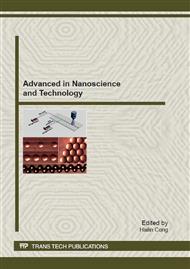p.66
p.72
p.76
p.80
p.86
p.91
p.95
p.101
p.108
Study of the Manufacture about Nanogenerators and their Performance
Abstract:
With the development of science and technology, the smaller sizes generator, the more attention by people. The main purpose of this article is to manufacture three-phase nanogenerator and piezoelectric nanogenerator under vibration, and their working principle are introduced and their performances are studied. The results show that, using the present nanomaterials, three-phase nanogenerator and piezoelectric nanogenerator can be prepared. In ambient vibration condition, piezoelectric materials produce larger rated current and voltage. However, copper laps cutting magnetic line of force produce less rated current and voltage. So the piezoelectric nanogenerator can be separately used to supply power. It may produce higher voltage, current and power if three-phase nanogenerator and piezoelectric nanogenerator in series-parallel connection, and there is commercial value.
Info:
Periodical:
Pages:
86-90
Citation:
Online since:
February 2012
Authors:
Keywords:
Price:
Сopyright:
© 2012 Trans Tech Publications Ltd. All Rights Reserved
Share:
Citation:


